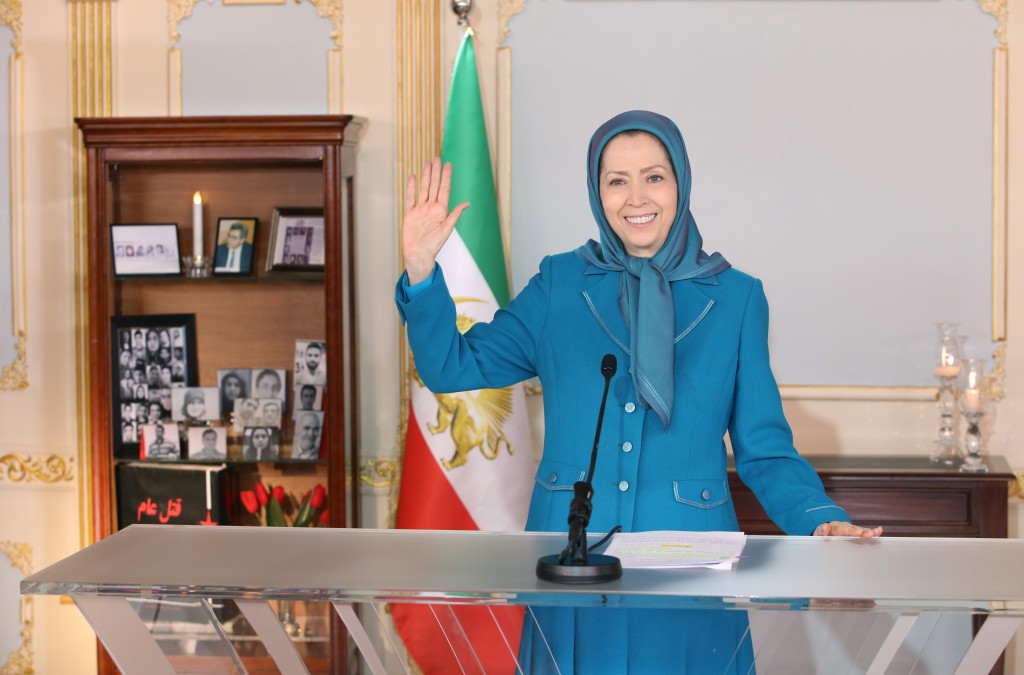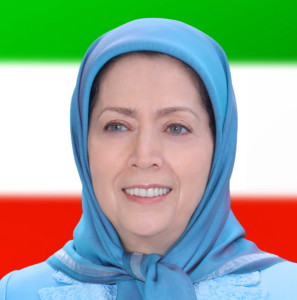No to the Regime of Executions and Massacres – The Imperative of International Prosecution of Khamenei and Raisi

Remarks by Maryam Rajavi, on the World Day Against the Death Penalty
Dear Compatriots,
Rebellious Supporters,
German Friends of the Iranian Resistance,
I salute you all who have gathered in Berlin to express solidarity with the Iranian people’s struggle for the overthrow of the Iranian regime; the regime of executions and massacres. I would also like to express my gratitude to all the compatriots and supporters of the Resistance who over the past four days have held gatherings in various cities in Europe, the United States, and Canada to commemorate this occasion.
On this World Day Against the Death Penalty, we pay tribute to the 120,000 martyrs and the fallen for freedom, particularly the 30,000 massacred political prisoners in 1988, over 90% of whom were members and supporters of the Mujahedin-e Khalq (MEK).
The mullahs’ regime is the world’ leading executioner of women
This year’s World Day Against the Death Penalty has been dedicated to women, which is a further cause for condemnation and expression of abhorrence toward the misogynist regime, more than any other regime. The ruling theocracy in Iran carries out the highest number of executions against women in the modern world.
On this World Day Against the Death Penalty, the cries of the executed political prisoners and prisoners that were murdered under torture can be heard in Iran‘s blood-stained skies. On this day, we hear the cries of martyred rebels who participated in the Khuzestan or Saravan uprisings, inviting all Iranians to rise up to overthrow the ruling murderers.
A day to express outrage and to detest the clerical regime
The World Day Against the Death Penalty is a day to express outrage and to detest the clerical regime, which carries out the highest number of executions in the entire world on a per capita basis.
This is a regime that has conducted the largest massacre of political prisoners since the Second World War. It murdered at least 1,500 people on the streets during the November 2019 uprisings, rendering it the record-holder when it comes to the number of killings of protesters.
Indeed, this is the only regime in the world in which the highest officials, from the President to the Judiciary Chief and the Parliament Speaker are either personally involved in massacres or directly carry out executions, torture and suppression. It is the only regime where its leadership entity, Khamenei’s office, is the command center for killings, terrorism, and assassinations.
Indeed, why would a world that has declared the World Day Against the Death Penalty to convey its sense of shame and injured conscience regarding executions, a world that accepted the Universal Declaration of Human Rights over seventy years ago, tolerate a theocracy immersed in executions and massacres in Iran?
And, why does the United Nations accept a regime, which according to the UN Secretary General, is holding 85 minors on death row in its prisons as we speak?
Previously, Amnesty International had described the Iranian regime as the “Last Executioner of Children.”
Khamenei needs to execute, but with every execution, he fans the flames of uprisings
The clerical regime relies on executions inside Iran, and due to Western governments’ protracted and chronic policy of appeasement, the regime enjoys impunity for its crimes abroad.
As the Secretary General of Amnesty International said, “That Ebrahim Raisi has risen to the presidency instead of being investigated for the crimes against humanity of murder, enforced disappearance, and torture is a grim reminder that impunity reigns supreme in Iran.”
In his report to the UN Secretary General this year, the UN Special Rapporteur on the Situation of Human Rights in Iran said that “There is a widespread and systemic impunity in the country for gross violations of human rights, both historically in the past as well as in the present.”
It is on this basis that [the regime’s Supreme Leader Ali] Khamenei installed [Ebrahim Raisi] “the 1988 Henchman” as his president, metaphorically shooting the regime’s last arrow in its quiver, in a bid to save the theocracy. Amnesty International has warned that “Iranian [regime] authorities are responsible for the ongoing crime of enforced disappearance.”
Khamenei seeks to intensify suppression, torture and execution of all prisoners in an attempt to save the regime from being overthrown, similar to the 1988 massacre. For this purpose, the regime has imposed inhumane pressures not only on political prisoners but all prisoners. The regime tortures prisoners to the brink of death and effortlessly sends them to the gallows in a bid to intimidate the society and, in its view, to block the path of uprisings.
But today, the social readiness for the overthrow of the regime and the anti-suppression activities of Resistance Units have created a situation where the execution of even a single prisoner or the cries of a single detained individual under torture pushes the entire regime closer to being overthrown.
Khamenei needs to execute, but with every execution, he fans the flames of uprisings.
As the Iranian Resistance’s Leader has said, “The response by Khomeini and Khamenei has been one thing and one thing alone: Murder, execution, massacre, installing the 1988 Henchman, and the continuation of all this in June 2009, December 2017, and November 2019. This is exactly why one must uproot the despised dictatorship of the velayat-e faqih [absolute clerical rule] in its entirety and hasten its collapse.”
Today, in addition to conducting serial executions of political prisoners, the ruling regime of henchmen, has resorted to the gradual killing of ill political prisoners as another method of execution. Political prisoner Sasan Nik Nafs lost his life because prison guards prevented his hospitalization, and imprisoned Dervish Behnam Mahjoubi died after he was deprived of access to medical care.
This month, the mullahs exhibited sheer cruelty by executing Abbasqoli Salehi, a brave Bakhtiari and a popular resident of Yazdanshahr suburb in Isfahan, after 20 years of imprisonment.
The videos that were leaked after the hacking of Evin prison’s internal closed-circuit cameras, revealed a small portion of the mullahs’ brutality against prisoners. The footage showed, for example, how prison guards were dragging a weakened and wounded prisoner up the stairs to transfer him to the prison. They use these methods repeatedly, killing innocent prisoners under torture; prisoners like Hadi Attarzadeh in Ahar Prison and Shahin Naseri, who exposed the torture of national hero Navid Afkari.
Indeed, can there be the slightest doubt about the certainty of the Iranian people’s ultimate triumph and freedom when a nation and its courageous children sacrifice in this way for the attainment of freedom?
We salute all these martyrs who are the flag bearers of the Iranian people’s refusal to surrender and the harbingers of the great uprisings that will spell the end of this regime.
The Iranian people demand the international prosecution of the regime leaders
In today’s world, rejecting the death penalty and engaging in resistance against the denial of the right to life is indispensable to confronting and overthrowing the mullahs’ monstrous and reactionary regime. As such, it is a source of pride for the Iranian people that a movement, such as the MEK, has risen up and hoisted the flag of bringing down the institution of execution and massacre through enormous sacrifice.
The Iranian Resistance has pushed the regime into a corner by expanding the Justice Movement for the victims of the 1988 massacre both inside Iran and internationally. The Iranian Resistance’s legal campaign that led to the Swiss Federal Court’s order to reopen and expand investigations into the assassination of Dr. Kazem Rajavi, the great martyr of human rights in Iran, in the context of genocide and crimes against humanity, marked a watershed moment for the Justice Movement for the victims of the 1988 massacre.
During the trial of henchman Hamid Noury, who worked in Gohardasht Prison in Karaj in 1988, the efforts by the MEK and the Iranian Resistance and the active and constant presence of the Resistance’s supporters in Stockholm as well as the effective testimony of many former political prisoners, who are MEK members or supporters, which is continuing, prevented the mullahs’ intelligence services and mercenaries from exploiting this trial and focused it on prosecuting the leaders of the regime.
Today, an invaluable international consensus demands that the High Commissioner for Human Rights and the Human Rights Council establish an international fact-finding mission to address and investigate the 1988 massacre.
In June, the United Nations special rapporteur for the situation of human rights in Iran called for an independent investigation into the massacre of political prisoners in 1988 and henchman Raisi’s role in that great crime. For their part, Amnesty International and over 150 renowned human rights advocates have also highlighted the need for the creation of such a delegation.
Several months ago, seven United Nations Rapporteurs announced that the UN inaction vis-à-vis the 1988 massacre had emboldened the Iranian regime and led to the deterioration of the situation of human rights in Iran.
On this World Day Against the Death Penalty, we reiterate and emphasize that the regime’s leaders must be brought to justice for committing genocide and crimes against humanity.
We call on the UN Secretary General, the High Commissioner for Human Rights, the Human Rights Council, UN special rapporteurs, and international human rights organizations to act in order to visit the regime’s prisons and meet with political prisoners.
The horrific human rights violations dossier in Iran, especially the regime’s actions in prisons, including in particular the ill-treatment and torture of female prisoners, must be referred to the UN Security Council.
The Iranian people demand the international prosecution of Khamenei, Raisi, [regime Judiciary Chief Gholam-Hossein] Eje’i, and other henchmen responsible for massacres and murders in Iran.
In the face of executions and massacres, which are the primary instruments of a regime to preserve its decrepit and illegitimate rule, our people’s response can be summed up in Resistance Units, uprisings, and the great army of freedom for the clerical regime’s overthrow.
In contrast to the mullahs’ cruelty, we honor compassion and humanity
We have risen up for an Iran without torture and suppression and devoid of discrimination and inequality;
For the establishment of a democratic republic based on the separation of religion and state, and for a non-nuclear Iran, where the death penalty is abolished;
An Iran with “an independent judiciary and legal system consistent with international standards based on the presumption of innocence, the right to defense counsel, the right of appeal, full independence of judges, and abolishment of the mullahs’ Sharia law.”
In contrast to the mullahs’ cruelty and callousness, we honor compassion and humanity.
This is a message that promotes solidarity and friendship in Iranian society; a message that galvanizes powerful uprisings to end the regime of executions and massacres; and this outcome will surely be realized.
Long live the people of Iran
Long live freedom
- Tags: 1988 Massacre, execution, Human Rights, Women

